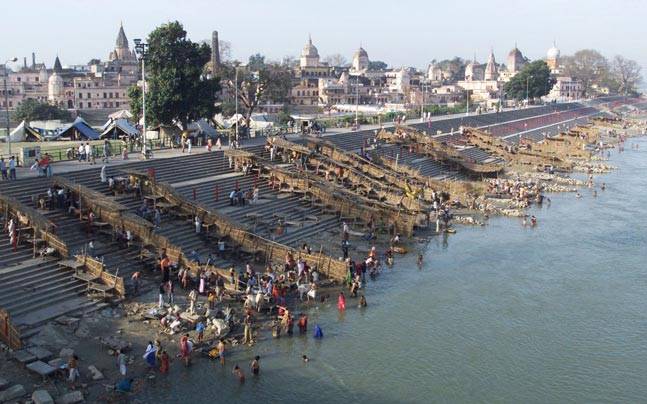The arguments for building the Ram Mandir in Ayodhya have so far been confined to historical and faith based arguments. However, one of the biggest positive effects the Ram Mandir construction would have so far has not been discussed by anyone. This positive effect will be on the economy. A Ram temple in Ayodhya will be a better option for the economy of Ayodhya and eastern UP than almost anything that can be build in its place.
Why is the mandir economically the best choice? First of all let us look at the demand for a Ram Mandir at the Ram Janam Bhoomi. There are almost 1 billion Hindus in the world. Let us say for the sake of argument that only 10% of total Hindus are bhakts of Ram. This percentage of Hindus amount to 100 million people. For 100 million people, there will be no holier pilgrimage than the Ram Janam Bhoomi in Ayodhya. For their faith this place will be to them what Mecca is for Muslims, Jerusalem is for Jews and Vatican for the Catholics. In comparison, let’s look at Harmandir Sahib the holiest place for followers of the Sikh Panth. What is the most revered place for them? Harmandir Sahib in Amritsar. How many people visit Harmandir Sahib daily? Estimates say close to 1 00 000 people per day, in a year that is roughly 3, 65, 00, 000 people per year. If Harmandir Sahib can show that good numbers with just 27 million followers, imagine what a Ram Mandir in Ayodhya could pull with 100 million followers. Now, people will say that it is not only Sikhs that visit Harmandir Sahib. The Ram Mandir in Ayodhya will only have the same effect as it will not only be Hindus that come to visit which means the number of visitors could potentially be a lot higher.
What does this mean for the small town of Ayodhya and Eastern UP?
Right now the only places that get tourism in Eastern UP are Varanasi and Prayagraj. Varanasi is one of the oldest cities in the world and one of the most visited places in India. Prayagraj gets tourism on a seasonal basis whenever a Mela is held although the city is very important for other purposes like the Allahabad High Court. The city of Ayodhya has a population of 600 000. What is Ayodhya known for? Does it have beaches? Is it a hill station? Does it have a historical building? Or is there some type of industry like a TATA auto plant or Reliance Refinery? The truth is Ayodhya is only known for one thing and one thing only. That is the great King Shri Ram. This is already evident and indisputable as the only tourist destinations responsible for the economy of the city and surrounding areas are temples such as Hanumangarhi, Sri Maniram das Chavani, etc. As a matter of fact, if you look on Trip Advisor for things to do in Ayodhya, 11 out of 12 attractions are all related to Maryada Purushottam Shri Ram. Ayodhya is dependent on Shri Ram even today without the Mandir. When the Ram Mandir is built, the floodgates will open and millions of people will visit. This would be the perfect opportunity to open businesses and people of all castes and religions would benefit tremendously from this. Muslims who live in Ayodhya would have their property and land values skyrocket and in the long run they could come out as very rich people if they play their cards right. Further, infrastructure would tremendously improve as the demand for better roads, bridges, electricity and water would significantly rise.
Let’s look at the opposite. If a Babri Mosque were to be built what benefit would it do to the economy? Only 7% of the population in the immediate area (including Faizabad) is Muslim. This is further split between sunnis and shias (who have no problem and in essence actually support the construction of the Mandir). For other muslims what importance would Babri Masjid have? Is it an integral part of Islam? Would people go Babri Masjid instead of Macca or Ajmer Sharif Dargah? Would people from all over the world come to Babri Masjid? The truth quite frankly is that a Babri Masjid would be not only a waste of resources but also detrimental to the economy. What about a hospital, school, park…? It is hard to argue constructing these would be a waste of resources but it would still be a horrendous, wasteful economic decision when you weigh the opportunity cost. When you consider the fact that these service points could be built anywhere in Ayodhya besides the Ram janam Bhoomi and the fact that doing so would come with the opportunity cost being potentially in the crores of rupees, it is not hard to see why.
The people of Ayodhya and surrounding area will benefit tremendously from supporting the building of a temple. With millions of people going on a pilgrimage to the Ram Janam Bhoomi the local area would see tremendous development. Land values would rise, businesses would flourish and people would become rich. From an economic perspective, the Ram Mandir would provide a tremendous positive externality. So who in their right mind would oppose such an opportunity to become rich and instead advocate another mosque, hospital, school, park etc, which could be built anywhere.
